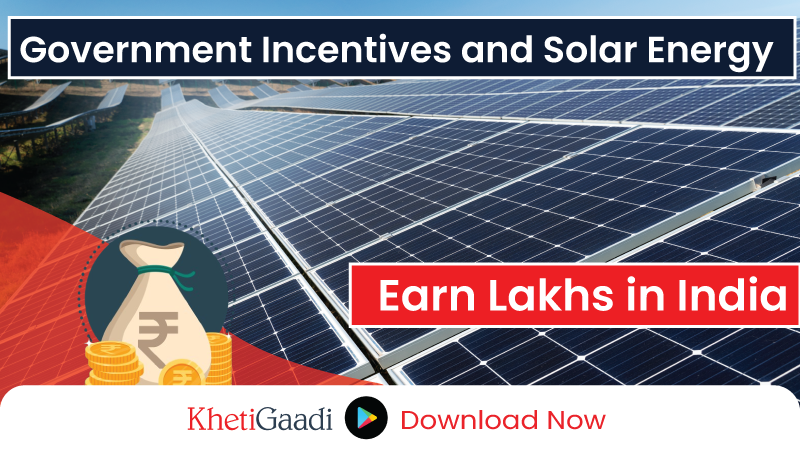The renewable energy sector, particularly solar power, has emerged as a profitable and sustainable business opportunity in India. With the government’s push towards renewable energy and the increasing demand for clean power, investing in a solar power plant can yield substantial financial returns. In this blog, we’ll explore the process of starting a solar power plant, the benefits it offers, how to generate income, and government subsidies available. We’ll also touch upon some of the latest technological advancements in solar power and share success stories to inspire your journey.
Overview of Solar Power Plants
A solar power plant is an installation that uses solar panels to convert sunlight into electricity. These panels are typically mounted on rooftops, open land, or even water bodies. The energy generated can either be used for personal consumption, reducing electricity bills, or sold back to the grid for profit. India, with its vast geographical expanse and abundant sunlight, has immense potential for solar energy production.
India ranks among the top five solar energy-producing countries globally, with a total installed capacity of over 60 GW as of 2024. The Indian government’s ambitious targets, such as achieving 280 GW of solar capacity by 2030, have created a favourable environment for investing in solar power plants.
Benefits of Solar Plants
Investing in solar plants offers several advantages:
- Sustainable and Renewable Energy Source
Solar energy is a clean, green, and inexhaustible source of power. By investing in solar plants, you contribute to reducing carbon emissions and combating climate change. Each kilowatt-hour (kWh) of solar power generated offsets approximately 0.75 kg of CO2 emissions.
- Low Operating Costs
Once installed, solar power plants require minimal maintenance. Solar panels typically come with a 25-year performance warranty, ensuring long-term energy production with low operational costs. The maintenance costs are primarily limited to periodic cleaning and occasional checks on the electrical components.
- Government Incentives
The Indian government offers various incentives, subsidies, and tax benefits to encourage the adoption of solar energy. For example, the government provides a capital subsidy of up to 30% for solar rooftop installations under the Ministry of New and Renewable Energy (MNRE) scheme. Additionally, there are accelerated depreciation benefits that allow investors to claim a 40% depreciation in the first year itself.
- Stable and Predictable Income
Solar power plants can generate a stable and predictable income stream. Selling excess electricity to the grid under the net metering policy ensures a steady cash flow. The Power Purchase Agreements (PPA) typically span 15-25 years, offering long-term financial security.
How to Start a Solar Power Plant
Starting a solar power plant involves several steps, each requiring careful planning and execution.
- Feasibility Study and Planning
Before setting up a solar power plant, conduct a feasibility study to assess the solar potential of the site, land availability, and proximity to the grid. The study should also include an analysis of the expected energy generation, project costs, and return on investment (ROI).
- Investment Costs: The cost of setting up a 1 MW solar power plant in India is approximately INR 4-5 crore. This includes the cost of land, solar panels, inverters, installation, and grid connection.
- Expected Returns: A 1 MW solar plant can generate approximately 1.5 million kWh of electricity annually. With a PPA rate of INR 3-5 per kWh, the annual revenue can range from INR 45 lakh to INR 75 lakh. Given the initial investment, the payback period typically ranges from 5 to 7 years, after which the plant generates pure profit.
- Obtaining Permits and Approvals
You will need to obtain various permits and approvals from local and state authorities, including land use permissions, environmental clearances, and grid connectivity approvals. Working with a consultant or a solar EPC (Engineering, Procurement, and Construction) company can simplify this process.
- Choosing the Right Technology
Selecting the appropriate solar panels, inverters, and other equipment is crucial for the efficiency and longevity of the plant. Monocrystalline and polycrystalline panels are the most commonly used, with efficiencies ranging from 17% to 22%. Inverters should be chosen based on the plant’s capacity and expected output.
- Installation and Commissioning
Hire experienced contractors for the installation of solar panels, inverters, and other equipment. After installation, the plant must be commissioned and connected to the grid. The commissioning process includes testing the system’s performance and ensuring compliance with grid regulations.
How to Earn Through Solar Plants
There are several avenues to generate income through solar power plants:
- Selling Electricity to the Grid
One of the primary sources of income is selling the electricity generated by your solar plant to the grid. Under the government’s net metering policy, you can sell excess electricity and receive payments based on the power generated.
For instance, if your plant generates 1.5 million kWh annually and you sell it at INR 4 per kWh, your annual income from selling electricity would be INR 60 lakh. Over the plant’s 25-year lifespan, this could amount to over INR 15 crore in revenue.
- Solar Power Purchase Agreements (PPA)
You can enter into a Power Purchase Agreement (PPA) with businesses or individuals who need electricity. In this case, you install the solar plant on their property, and they pay you for the electricity generated. PPAs provide a fixed revenue stream, often with rates higher than the grid rate, offering a secure income source.
- Solar Leasing
Another option is to lease your solar power plant to a third party. In this arrangement, you retain ownership of the plant while the lessee pays you a fixed amount for using the plant to generate electricity. This model reduces the financial burden on the lessee while providing you with a steady income.
Government Subsidy for Solar Plants
The Indian government offers various subsidies and incentives to promote solar energy adoption. The MNRE provides capital subsidies, particularly for rooftop solar installations, which can cover up to 30% of the total cost. For residential installations, state governments may offer additional subsidies or incentives.
- Loans and Financing: Several public and private sector banks offer loans for solar power projects at competitive interest rates. These loans typically cover up to 70% of the project cost, with flexible repayment options ranging from 10 to 15 years.
- Accelerated Depreciation: Under the Income Tax Act, solar power plant owners can claim accelerated depreciation benefits, allowing them to depreciate 40% of the project’s value in the first year, reducing the taxable income significantly.
Latest Technology in Solar Panels/Plants
The solar industry is constantly evolving, with new technologies enhancing the efficiency and cost-effectiveness of solar power plants. Some of the latest advancements include:
- Bifacial Solar Panels
Bifacial solar panels can capture sunlight from both sides, increasing energy generation by 10-20% compared to traditional panels. These panels are particularly effective in regions with high reflectivity, such as deserts or snowy areas.
- Solar Tracking Systems
Solar tracking systems allow panels to follow the sun’s movement throughout the day, optimizing energy capture. Single-axis trackers can increase energy production by 20-30%, while dual-axis trackers offer even higher gains, albeit at a higher cost.
- High-Efficiency Inverters
Modern inverters are more efficient in converting DC to AC, reducing energy loss. Hybrid inverters, which can work with both solar panels and battery storage systems, are becoming increasingly popular for residential and commercial installations.
- Energy Storage Solutions
Battery storage systems are becoming more affordable, allowing for the storage of excess energy for later use or sale. Lithium-ion batteries are currently the most popular choice, offering high energy density and long life.
Success Stories
Success Story 1: Green Energy Pvt. Ltd.
Green Energy Pvt. Ltd. is a small business in Rajasthan that started with a 1 MW solar power plant in 2016. The company invested INR 4.5 crore, availing a 30% subsidy from the government. Within the first year, the plant generated 1.5 million kWh of electricity, sold at INR 4.5 per kWh, earning INR 67.5 lakh. The business recovered its initial investment within six years and has since been generating a steady income, allowing them to expand their operations to 5 MW.
Success Story 2: Solar Solutions LLP
Solar Solutions LLP, based in Gujarat, opted for a solar leasing model. They installed a 2 MW solar plant on an industrial estate, leasing it to the estate owners for INR 20 lakh per annum. The leasing model allowed Solar Solutions LLP to recover their investment of INR 9 crore in just over eight years, with the remaining lease period generating pure profit.
Conclusion
Investing in a solar power plant in India is a profitable and sustainable venture. With the right planning, technology, and utilization of government subsidies, you can earn in lakhs through solar energy. The sector’s growth potential, ongoing technological advancements, and support from the government make it an attractive investment for anyone looking to enter the renewable energy market.
Reference Links
Ministry of New and Renewable Energy (MNRE)
Solar Energy Corporation of India (SECI)
Bureau of Energy Efficiency (BEE)
Tags




